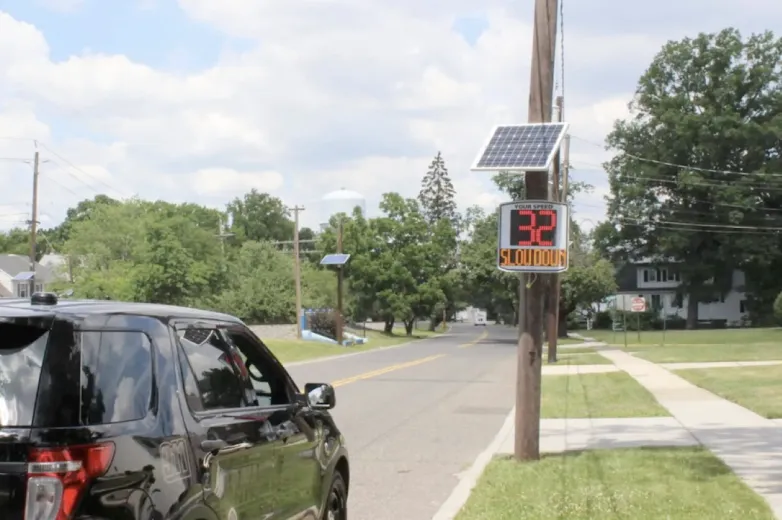Radar Speed Signs vs. Traditional Speed Control : What Works Best ?

If you drive through a neighborhood and you notice cars speeding past a school, it can be unsettling. That’s because you want streets to be safer. Speeding is a significant problem—and the leading cause of many traffic fatalities. So, how do you stop this menace? Is it with modern radar speed signs or traditional methods like speed bumps? Although the two are known to slow down traffic, they differ in approach, cost, and impact. In this article, you will discover which one delivers the best results for safety and practicality.
Radar Speed Signs
You’ve seen those glowing signs that flash speed. A radar speed sign can detect a car’s speed and display it in real time. They alert drivers with LED numbers, often in green for safe speeds or red for speeding. Some add smiley faces or warnings like “Slow Down.” This instant feedback nudges you to ease off the gas. Actually, studies show that drivers slow down 80 % of the time when they see their speed displayed. You can place them in school zones, residential streets, or work zones. They’re also really easy to install and are often solar-powered. They collect data to track speed patterns. This way, you know where the problems are worst.
Traditional Speed Control Methods
Are you familiar with speed bumps, humps, and roundabouts? These physical barriers force drivers to slow down or risk damaging their vehicles. Speed bumps are short and sharp, while humps are wider for a gentler slow. Roundabouts, on the other hand, redirect traffic and will cut down speed naturally. Additionally, police enforcement, such as the use of radar guns or patrols, is also effective, but it requires a dedicated workforce. You might see static signs too; they usually remind drivers of the speed limits. These methods are time-tested, but they do have their limits. They can be costly, too disruptive, or rely on inconsistent enforcement.
Which Option is Best at Controlling Speed Limit?
Now that you know what each speed limit option can do. The question, however, is which option is the best? Let’s see how the two speed controls stack against each other:
Effectiveness in Reducing Speed
Radar speed signs can reduce speeds by 10-20% on average, and it has been known to drive high compliance. It works best on “super speeders” going 20 mph over the limit. Also, speed reductions have been shown to last up to two years, even without enforcement.
Traditional methods like speed humps cut speeds by 20-25% but affect every driver, even those already going slow. Roundabouts can reduce speeds by 15-20%. Police patrols deter speeding, but only when they are present. It’s safe to say that radar signs offer consistent and targeted impact without physical force.
Safety and Accident Prevention
Radar speed signs are known to lower accident risks by slowing traffic. If a pedestrian moves at 40 mph, they face a 90 % fatality rate, but at 20 mph, it’s just 10%. If these Signs are in school zones, they cut speeds by 3-9 mph, making it safer for pedestrians.
Traditional methods like humps reduce collisions by 40% in residential areas, while roundabouts cut severe crashes by 30 %. However, humps can delay emergency vehicles, and enforcement depends on whether police are available. Radar signs don't block roads, and they work 24/7 to prevent accidents without disrupting traffic flow.
Cost and Maintenance
Suppose you’re concerned about your budget. You should know that Radar speed signs cost around $2,000 to $5,000. They also require minimal upkeep. If you get the solar-powered models, like those from Elancity, it cuts energy costs. You can install them in minutes, and with no roadwork needed.
Speed humps, however, can cost anywhere between $2,000 $10,000 per unit, plus they have repaving expenses. Roundabouts cost between $50,000 and $500,000 to build, while police patrols will incur labor costs. In the long run, Radar signs are actually more affordable since they require a one-time buy and have a long-term impact.
Conclusion
Now, you can decide which option works best for you. If you want to be sure to slow down traffic in your neighborhood and around school zones, Radar speed signs work best. They are very affordable, flexible, and community-friendly. Even though traditional methods like speed humps or roundabouts work, they are costlier and less adaptable. Radar signs offer 24/7 feedback, they will collect data, and even better, they are easy to set up. Therefore, for reliable and modern traffic calming, radar speed signs outperform traditional speed control measures.
Also read
- How to Reduce Downtime in Solar Operations?
- Hyperparameter Tuning Good Practices for Robust Predictive Models
- 5 Critical Metal Forming Processes in Solar Panel Manufacturing
- Maximizing Efficiency with Low-Maintenance Solar Panel Systems
- Cyber Hygiene for Solar Companies: Protecting Your Data from Email Threats


